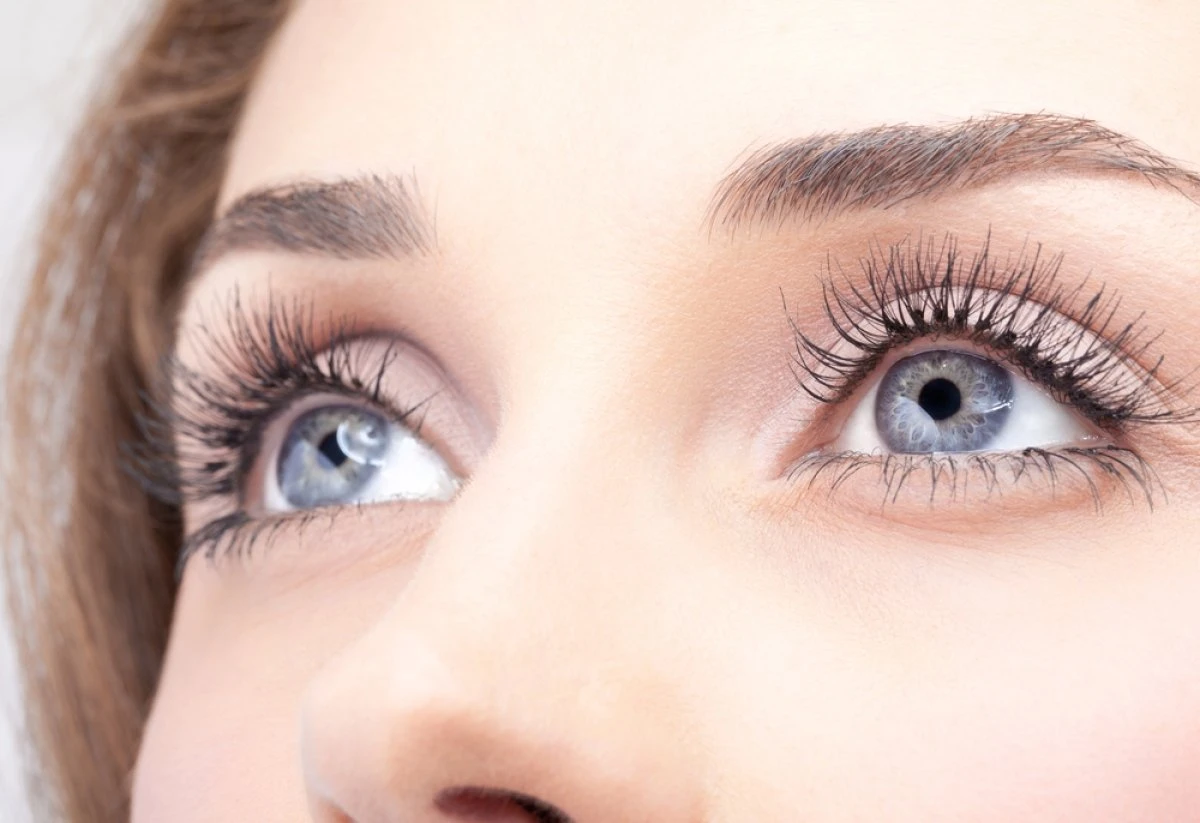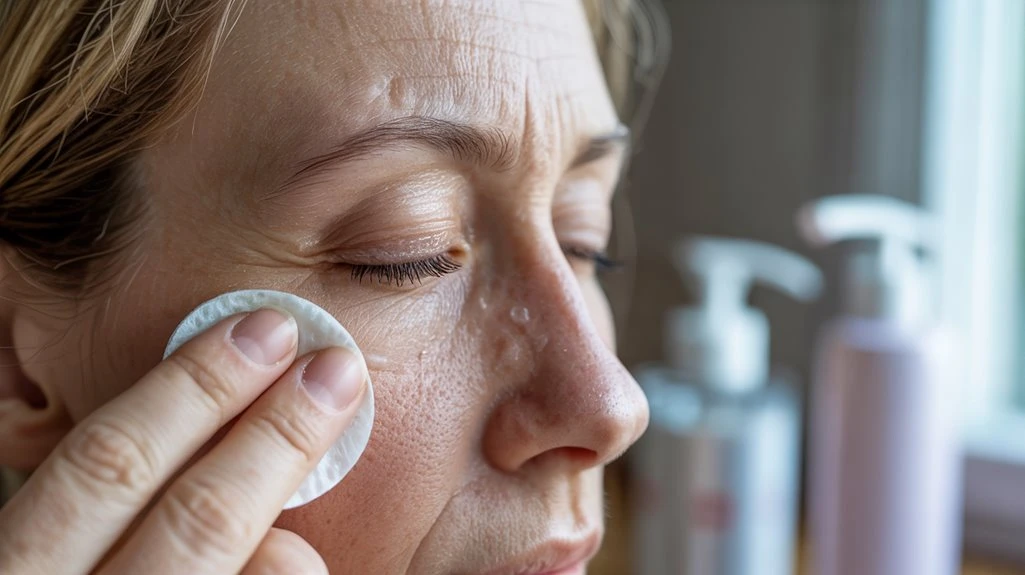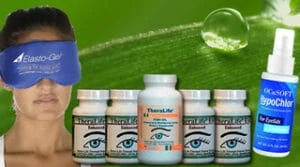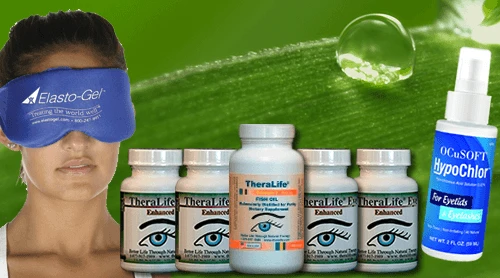Eyelid dryness can often arise from disruptions in the skin barrier caused by dermatological conditions such as eczema or dermatitis. Factors like aging, irritating makeup, skincare products, and certain medications can exacerbate the issue. While environmental factors like weather rarely have a direct impact, understanding these causes can help in identifying and addressing the symptoms.
TheraLife’s unique approach to treating eyelid dryness sets it apart, as it is the only company offering oral eye treatment care. Their products are specially designed to benefit customers by targeting the root causes of dryness and inflammation, providing a comprehensive solution that goes beyond topical treatments. By choosing TheraLife, you can explore targeted solutions that address the underlying issues contributing to your symptoms.
Best Oral Dry Eyelids Treatment That Works
Add To Cart
Key Takeaways
- Dermatologic conditions such as eczema, atopic dermatitis, and seborrheic dermatitis are leading causes of eyelid dryness.
- Makeup, skincare products, and cleansers containing irritants or harsh chemicals can disrupt the eyelid skin barrier and cause dryness.
- Aging thins the eyelid skin and reduces oil production, increasing susceptibility to dryness and irritation.
- Medical conditions like blepharitis and meibomian gland dysfunction contribute to eyelid dryness through chronic inflammation and impaired tear film.
- Certain medications and chronic diseases can decrease skin hydration or tear production, resulting in dry eyelids.
Environmental Factors and Weather
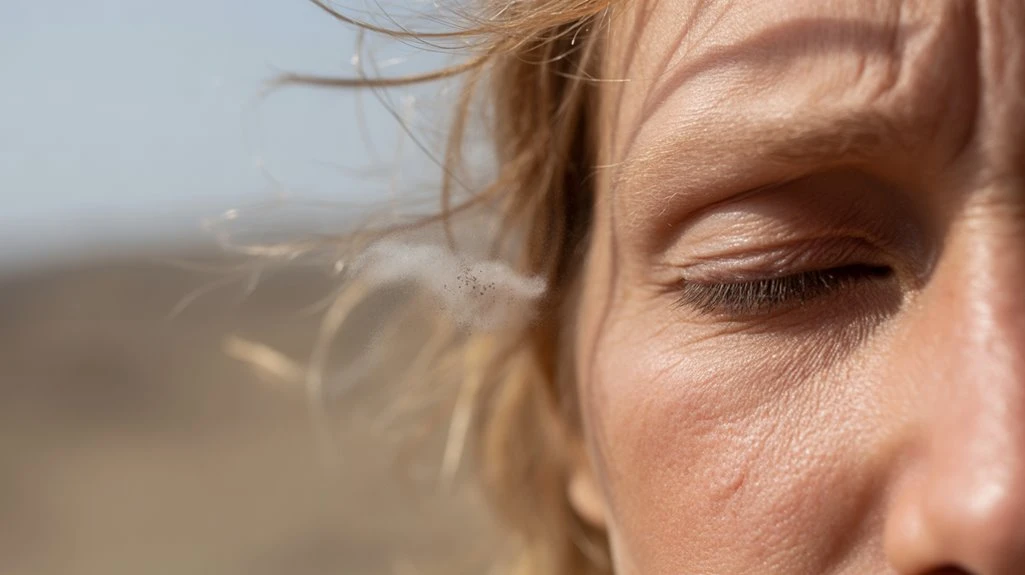
Although many assume that environmental factors and weather contribute considerably to eyelid dryness, clinical evidence doesn’t support this claim.
You might expect that fluctuations in humidity levels or seasonal changes would have a significant impact on the ocular adnexa, particularly the delicate skin of the eyelids. However, studies indicate that neither low humidity nor variations associated with different seasons directly cause eyelid dryness.
Instead, the eyelid’s unique anatomical and physiological properties provide a barrier that limits transepidermal water loss, regardless of ambient humidity levels. While general skin dryness may increase during certain seasonal changes, the eyelid demonstrates resilience to these external variables.
Consequently, you shouldn’t attribute eyelid dryness primarily to environmental factors or weather conditions based on current evidence-based research. Chronic dry eyes can result from autoimmune diseases and other factors not related to the environment.
Allergies and Irritants
While many individuals suspect that allergies and common irritants are primary drivers of eyelid dryness, current clinical evidence doesn’t substantiate this association.
Although you might attribute discomfort to allergens or irritants, studies indicate no direct causal relationship between these factors and true eyelid dryness. Symptoms such as itching, redness, or swelling may arise from allergic conjunctivitis or exposure to irritants, yet these don’t inherently cause dryness of the eyelid skin.
Instead, other mechanisms are more likely responsible. Consider these clinically relevant points:
- Allergic reactions typically cause swelling, erythema, and pruritus, not dryness.
- Contact lens use may exacerbate ocular surface irritation, but doesn’t primarily induce eyelid dryness.
- Eye strain doesn’t directly impact eyelid hydration.
- Irritants may provoke acute inflammation, without persistent dryness.
Furthermore, Sjogren’s syndrome can cause dryness of the eyes and surrounding skin, highlighting the importance of considering autoimmune conditions in persistent dryness cases.
Skin Conditions Affecting the Eyelids
Beyond allergens and irritants, underlying dermatologic conditions frequently contribute to eyelid dryness. You might notice symptoms such as scaling, erythema, or pruritus, all of which can indicate specific skin disorders. Eyelid eczema is a common culprit, characterized by barrier dysfunction and inflammatory infiltration. Atopic dermatitis and seborrheic dermatitis also affect the delicate eyelid region, often exacerbated by environmental or endogenous dermatitis triggers. For those with rheumatoid arthritis, ocular inflammatory conditions may also impact the eyelids, further complicating existing skin issues. The table below outlines key conditions and features:
| Condition | Distinctive Features |
|---|---|
| Eyelid Eczema | Dryness, fissuring, lichenification |
| Atopic Dermatitis | Chronic itch, erythematous plaques |
| Seborrheic Dermatitis | Greasy scales, mild erythema |
Recognizing these conditions helps you differentiate primary dermatologic causes from secondary irritant exposures, allowing for targeted management. Identification of dermatitis triggers is essential for reducing recurrence and improving symptoms.
Effects of Makeup and Skincare Products
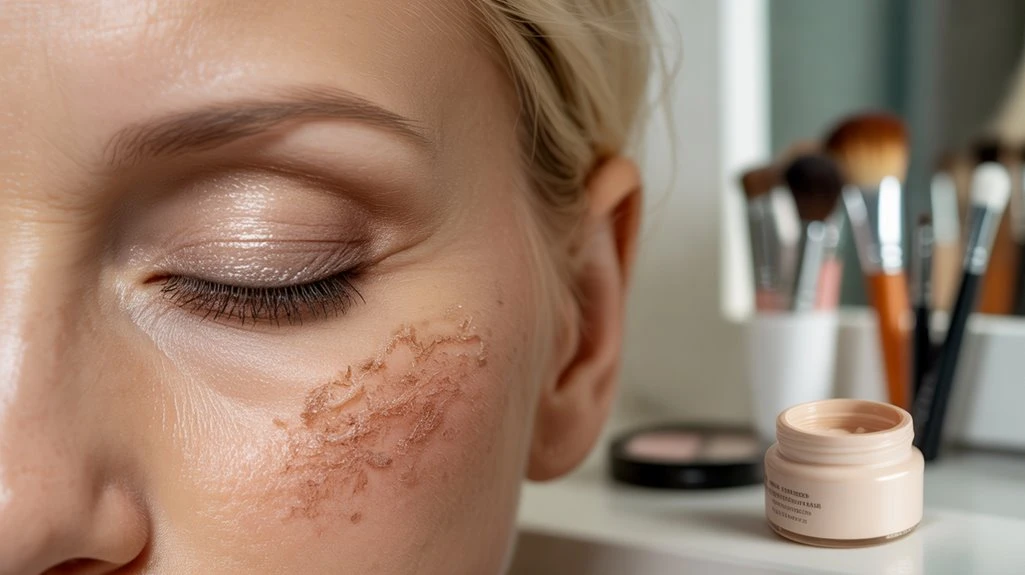
Certain makeup and skincare products frequently contribute to eyelid dryness due to their chemical constituents and potential for disrupting the skin barrier.
When you use products as part of your skincare routines or apply cosmetics, specific makeup ingredients may induce irritation, allergic reactions, or direct barrier dysfunction.
Evidence suggests that preservatives, fragrances, and alcohol-based formulations are common culprits. You can minimize risk by evaluating product labels and opting for hypoallergenic alternatives.
Key factors to examine include:
- Preservatives: Parabens and formaldehyde-releasing agents may cause sensitization and dryness.
- Fragrances: Synthetic and natural fragrances are frequent allergens, often leading to irritation.
- Alcohols: Denatured alcohols strip moisture, impairing the eyelid’s protective layer.
- Cleansers: Aggressive cleansers in skincare routines can erode the delicate periocular skin barrier.
Additionally, hypochlorous acid-based cleansers are recommended for sensitive eyes, as they help create a biofilm that inhibits bacterial re-attachment.
Aging and Changes in Skin Barrier
As you age, the skin of your eyelids becomes thinner and produces less sebum, reducing its ability to retain moisture. This decline in lipid production weakens the moisture barrier, making the eyelids more susceptible to dryness. These physiological changes increase your risk of irritation and discomfort in the periorbital area. Additionally, decreased heart function limits micro-circulation, affecting the blood supply to the eyelids and exacerbating the dryness.
Thinning Skin With Age
With age, the skin on your eyelids naturally becomes thinner due to a gradual decline in collagen and elastin production. This thinning compromises the skin barrier, making it less effective at retaining moisture and more susceptible to external irritants. Several evidence-based factors contribute to this process:
- Sun exposure: Chronic ultraviolet radiation accelerates collagen degradation, further reducing skin thickness and resilience.
- Dietary deficiencies: Inadequate intake of vitamins A, C, and E impairs the skin’s ability to repair and maintain its structure, exacerbating thinning.
- Decreased cellular turnover: Aging slows the regeneration of skin cells, diminishing the protective barrier function.
- Loss of subcutaneous fat: The reduction of fat beneath the eyelid skin leaves it more fragile and vulnerable to dryness.
Addressing these factors can help mitigate eyelid dryness as you age. Additionally, chronic dry eye conditions like blepharitis and meibomian gland dysfunction can exacerbate dryness around the eyelids, causing discomfort and further skin irritation.
Reduced Oil Production
Although the eyelid skin contains fewer sebaceous glands compared to other facial areas, these glands still play an essential role in maintaining moisture and protecting the ocular surface.
As you age, sebaceous gland activity declines, leading to reduced oil production. This decrease disrupts the lipid layer of the tear film, making your eyelids more prone to dryness and irritation.
Dietary impacts, such as insufficient intake of omega-3 fatty acids, can exacerbate diminished oil secretion. Additionally, inadequate hydration levels negatively influence the skin’s ability to retain moisture, further contributing to dryness.
Consuming Omega-3 fatty acids, found in fish oil supplements, can help improve the lipid layer of the tear film, reducing eye irritation and dryness.
Clinical evidence shows that both intrinsic aging and extrinsic factors, including nutritional status and fluid consumption, directly affect sebaceous gland function.
Monitoring your diet and maintaining proper hydration may help preserve eyelid moisture.
Weakened Moisture Barrier
Reduced oil production isn’t the only factor behind eyelid dryness; the structural integrity of the skin’s moisture barrier also plays a significant role.
As you age, the stratum corneum—the outermost layer of the skin—can lose essential lipids and proteins, compromising its ability to retain moisture. This weakened barrier results in increased transepidermal water loss, making your eyelids more susceptible to dryness, irritation, and environmental stressors.
Clinical studies confirm that age-related changes decrease moisture retention and disrupt ideal skin function. For effective management, barrier restoration is vital. Menopause Impact, particularly in women, also contributes to changes in skin and tear gland function, affecting moisture retention.
Consider these evidence-based approaches:
- Use ceramide-rich formulations to replenish lost lipids.
- Apply gentle cleansers to avoid further barrier disruption.
- Incorporate humectants like hyaluronic acid for enhanced moisture retention.
- Protect eyelids from harsh environmental exposures.
Medical Conditions and Medications
You may experience eyelid dryness due to underlying medical conditions such as blepharitis, which causes chronic inflammation of the eyelid margins. Allergic contact dermatitis and atopic dermatitis can also compromise the periocular skin barrier, increasing dryness. In addition, certain medications, including antihistamines and isotretinoin, are known to reduce tear production or alter skin hydration. Furthermore, meibomian gland dysfunction is a primary cause of blepharitis, which can exacerbate eyelid dryness by affecting the natural lubrication of the eye.
Blepharitis and Inflammation
When the eyelids become irritated or inflamed, conditions such as blepharitis often develop and contribute to eyelid dryness.
Blepharitis is a chronic inflammatory disorder affecting the eyelid margins, frequently caused by bacterial colonization or dysfunction of the meibomian glands. You may notice several blepharitis symptoms, including redness, swelling, and scaling along the lash line.
Eyelid inflammation disrupts the tear film, leading to increased evaporation and a sensation of dryness. If left untreated, chronic inflammation can result in structural changes and persistent discomfort.
Here’s what you should know about blepharitis and eyelid inflammation:
- Blepharitis symptoms include irritation, burning, and crusting at the lid margins.
- Chronic eyelid inflammation impairs normal tear production.
- Meibomian gland dysfunction is a common underlying factor.
- Effective management requires targeted hygiene and sometimes medication.
A systematic eyelid hygiene routine, including warm compresses and gentle massages, is essential for alleviating symptoms and improving meibomian gland function.
Allergy-Related Skin Issues
Beyond inflammation from conditions like blepharitis, allergy-related skin issues often provoke eyelid dryness through distinct mechanisms.
When you’re exposed to seasonal allergies, allergens such as pollen stimulate an immune response, releasing histamine and other inflammatory mediators. This reaction leads to skin inflammation, which compromises the delicate periocular skin barrier. As a result, transepidermal water loss increases, and your eyelids become more susceptible to dryness, irritation, and scaling.
Contact dermatitis—triggered by allergens in cosmetics, eye drops, or environmental sources—can also induce localized inflammation, further disrupting skin hydration. Persistent rubbing of the eyes due to pruritus exacerbates damage, perpetuating the dryness cycle.
Effective management requires identifying triggers, minimizing allergen exposure, and using barrier-repair moisturizers to restore the skin’s protective function.
Medication Side Effects
Several common medications and underlying medical conditions can directly contribute to eyelid dryness by altering skin physiology or tear film stability.
When you’re prescribed new drugs, it’s essential to evaluate medication interactions and their potential dermatologic side effects. Medications can disrupt the ocular surface in various ways, sometimes necessitating dosage adjustments to mitigate discomfort.
Here are four key examples to evaluate:
- Antihistamines: These reduce tear production, often leading to ocular and eyelid dryness.
- Retinoids (oral or topical): Frequently prescribed for acne, these disrupt sebaceous gland function, increasing dryness risk.
- Diuretics: Common in hypertension management, they can cause systemic dehydration, affecting eyelid hydration.
- Beta-blockers: Used for cardiovascular conditions, these may decrease lacrimal gland secretion, exacerbating dryness.
Always inform your healthcare provider about persistent symptoms.
Best Oral Dry Eyelids Treatment That Works
Add To Cart
Frequently Asked Questions
Can Diet Affect Eyelid Dryness?
You can experience eyelid dryness if your diet lacks essential nutrients or if your hydration levels are low.
Nutrient deficiencies, such as low levels of vitamin A, omega-3 fatty acids, or zinc, can impair the function of the meibomian glands, leading to reduced tear film stability.
Inadequate hydration decreases overall tear production.
Evidence shows optimizing nutrition and maintaining proper hydration levels help support ocular surface health and reduce eyelid dryness risk.
Is Eyelid Dryness Contagious?
If your eyelids are feeling a little less than their usual radiant selves, rest assured—eyelid dryness, including eyelid dermatitis, isn’t something you’ll pass along to others.
This condition typically arises from environmental factors like allergens, irritants, or weather changes, rather than infectious agents.
Evidence-based research confirms that eyelid dermatitis isn’t contagious.
You can manage symptoms by avoiding triggers and using appropriate topical treatments as recommended by your healthcare provider.
How Long Does Eyelid Dryness Usually Last?
The duration of eyelid dryness varies based on underlying etiology and intervention.
If you address triggers and use artificial tears or ointments for temporary relief, symptoms may resolve within days.
However, chronic conditions like blepharitis require long term solutions such as lid hygiene and prescription treatments.
Without intervention, dryness can persist or recur.
Evidence indicates that prompt identification and management greatly reduce symptom duration and improve ocular surface health over time.
Can Stress Trigger Eyelid Dryness?
Yes, stress can trigger eyelid dryness.
When you’re stressed, your body’s stress response may reduce tear production and alter the composition of your tear film, leading to dryness.
Anxiety effects can also disrupt hormonal balance and increase inflammation, further exacerbating symptoms.
Stress management techniques, such as relaxation exercises and mindfulness, help regulate these physiological responses.
Evidence suggests that controlling stress and anxiety can improve ocular surface health and alleviate eyelid dryness.
Are Children Prone to Eyelid Dryness?
Imagine your eyelids as delicate shields, much like a castle’s gatekeepers. In children, these shields can be sensitive, making them prone to eyelid dryness, especially if you overlook proper eyelid care.
Kids often face allergy reactions, environmental irritants, or underlying dermatological conditions like atopic dermatitis. Evidence indicates that pediatric eyelid skin is thinner and more susceptible to dehydration, so you’ll need to stay vigilant and practice gentle hygiene for ideal ocular surface health.
Best Oral Dry Eyelids Treatment That Works
Add To Cart
Conclusion
Eyelid dryness can be more than just a slight inconvenience—it’s a distress signal from your skin, often caused by factors like harsh winds, allergens, dermatologic conditions, or even eye makeup. Addressing these issues requires vigilance, skincare optimization, and sometimes medical advice. Fortunately, TheraLife offers a unique and effective solution. As the only company providing oral eye treatment care, TheraLife’s products are specially designed to enhance your eye health from the inside out, offering a fortified defense against eyelid dryness. By incorporating TheraLife into your routine, you’re equipping yourself with a powerful ally to protect your eyelids and ensure lasting comfort and relief.
References
- 1.Fowler AM, Dutton JJ. Floppy eyelid syndrome as a subset of lax eyelid conditions: relationships and clinical relevance (an ASOPRS thesis) Ophthal Plast Reconstr Surg. 2010;26:195–204. doi: 10.1097/IOP.0b013e3181b9e37e. [DOI] [PubMed] [Google Scholar]
- 2.Abrahamson IA. Eye changes after forty. Am Fam Physician. 1984;29:171–181. [PubMed] [Google Scholar]
- 3.Schlotzer-Schrehardt U, Stojkovic M, Hofmann-Rummelt C, et al. The Pathogenesis of floppy eyelid syndrome: involvement of matrix metalloproteinases in elastic fiber degradation. Ophthalmology. 2005;112:694–704. doi: 10.1016/j.ophtha.2004.11.031. [DOI] [PubMed] [Google Scholar]
- 4.Easterbrook M. Floppy eyelid syndrome. Can J Ophthalmol. 1985;20:264–265. [PubMed] [Google Scholar]
- 5.Judd KP. Hyperelasticity syndromes. Cutis. 1984;33:494–496. [PubMed] [Google Scholar]
- 6.Cho SY, Maguire RF. Multiple myeloma associated with acquired cutis laxa. Cutis. 1980;26:209–211. [PubMed] [Google Scholar]
- 7.Jordan DR. Blepharochalasis syndrome: a proposed pathophysiologic mechanism. Can J Ophthalmol. 1992;27:10–15. [PubMed] [Google Scholar]
- 8.Goldberg R, Seiff S, McFarland J, et al. Floppy eyelid syndrome and blepharochalasis. Am J Ophthalmol. 1986;102:376–381. doi: 10.1016/0002-9394(86)90014-0. [DOI] [PubMed] [Google Scholar]
- 9.Culbertson WW, Tseng SC. Corneal disorders in floppy eyelid syndrome. Cornea. 1994;13:33–42. doi: 10.1097/00003226-199401000-00007. [DOI] [PubMed] [Google Scholar]
- 10.Liu DT, Di Pascuale MA, Sawai J, et al. Tear film dynamics in floppy eyelid syndrome. Invest Ophthalmol Vis Sci. 2005;46:1188–1194. doi: 10.1167/iovs.04-0913. [DOI] [PubMed] [Google Scholar]

